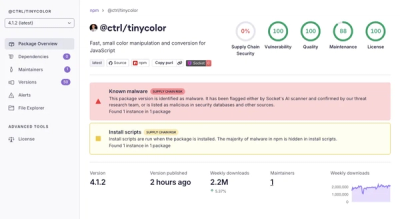facepaint
Dynamic style values for css-in-js.
import { css } from 'emotion'
import facepaint from 'facepaint'
const mq = facepaint([
'@media(min-width: 420px)',
'@media(min-width: 920px)',
'@media(min-width: 1120px)'
])
const myClassName = css(mq({
color: ['red', 'green', 'blue', 'darkorchid'],
}))
Install
npm i facepaint -S
or
yarn add facepaint
API
facepaint function
facepaint(selectors: Array<Selector>) : DynamicStyleFunction
Arguments
-
breakpoints
const mq = facepaint([
'@media(min-width: 420px)',
'@media(min-width: 920px)',
'@media(min-width: 1120px)'
])
-
options
const mq = facepaint(
[...],
{
literal: true|false,
overlap: true|false
}
)
- literal
boolean (Default: false) - force "slot"
- overlap
boolean (Default: false) - remove any duplicate values found in multiple "slots"
Returns
facepaint returns a function that can be exported and used throughout
your app to dynamically style based on your provided selectors.
- The function accepts any number of arrays or objects as arguments.
- Nested arrays are flattened.
- Boolean,
undefined, and null values are ignored.
Examples
emotion
CodeSandbox Demo
import { css } from 'emotion'
import facepaint from 'facepaint'
const mq = facepaint([
'@media(min-width: 420px)',
'@media(min-width: 920px)',
'@media(min-width: 1120px)'
])
const myClassName = css(mq({
backgroundColor: 'hotpink',
textAlign: 'center',
width: ['25%', '50%', '75%', '100%'],
'& .foo': {
color: ['red', 'green', 'blue', 'darkorchid'],
'& img': {
height: [10, 15, 20, 25]
}
}
}))
Note that the first value is considered a default value and is not a child of a media query at-rule.
The following css is generated.
.css-rbuh8g {
background-color: hotpink;
text-align: center;
width: 25%;
}
@media (min-width:420px) {
.css-rbuh8g {
width: 50%;
}
}
@media (min-width:920px) {
.css-rbuh8g {
width: 75%;
}
}
@media (min-width:1120px) {
.css-rbuh8g {
width: 100%;
}
}
.css-rbuh8g .foo {
color: red;
}
@media (min-width:420px) {
.css-rbuh8g .foo {
color: green;
}
}
@media (min-width:920px) {
.css-rbuh8g .foo {
color: blue;
}
}
@media (min-width:1120px) {
.css-rbuh8g .foo {
color: darkorchid;
}
}
.css-rbuh8g .foo img {
height: 10px;
}
@media (min-width:420px) {
.css-rbuh8g .foo img {
height: 15px;
}
}
@media (min-width:920px) {
.css-rbuh8g .foo img {
height: 20px;
}
}
@media (min-width:1120px) {
.css-rbuh8g .foo img {
height: 25px;
}
}
styled-components
import styled from 'styled-components'
import facepaint from 'facepaint'
const mq = facepaint([
'@media(min-width: 420px)',
'@media(min-width: 920px)',
'@media(min-width: 1120px)'
])
const Div = styled('div')`
${mq({
backgroundColor: 'hotpink',
textAlign: 'center',
width: ['25%', '50%', '75%', '100%'],
'& .foo': {
color: ['red', 'green', 'blue', 'papayawhip'],
'& img': {
height: ['10px', '15px', '20px', '25px']
}
}
})};
`
<Div/>
The following css is generated.
.c0 {
background-color: hotpink;
text-align: center;
width: 25%;
}
.c0 .foo {
color: red;
}
.c0 .foo img {
height: 10px;
}
@media (min-width:420px) {
.c0 {
width: 50%;
}
}
@media (min-width:920px) {
.c0 {
width: 75%;
}
}
@media (min-width:1120px) {
.c0 {
width: 100%;
}
}
@media (min-width:420px) {
.c0 .foo {
color: green;
}
}
@media (min-width:920px) {
.c0 .foo {
color: blue;
}
}
@media (min-width:1120px) {
.c0 .foo {
color: papayawhip;
}
}
@media (min-width:420px) {
.c0 .foo img {
height: 15px;
}
}
@media (min-width:920px) {
.c0 .foo img {
height: 20px;
}
}
@media (min-width:1120px) {
.c0 .foo img {
height: 25px;
}
}
Pseudo Selectors
CodeSandbox Demo
import { css } from 'emotion'
import facepaint from 'facepaint'
const pseudo = facepaint([':hover', ':active', ':focus'])
const myClassName = css(
pseudo({
backgroundColor: 'hotpink',
textAlign: 'center',
width: ['25%', '50%', '75%', '100%'],
'& .foo': {
color: ['red', 'green', 'blue', 'darkorchid'],
'& img': {
height: [10, 15, 20, 25]
}
}
})
)
.css-1guvnfu {
background-color: hotpink;
text-align: center;
width: 25%;
}
.css-1guvnfu:hover {
width: 50%;
}
.css-1guvnfu:active {
width: 75%;
}
.css-1guvnfu:focus {
width: 100%;
}
.css-1guvnfu .foo {
color: red;
}
.css-1guvnfu .foo:hover {
color: green;
}
.css-1guvnfu .foo:active {
color: blue;
}
.css-1guvnfu .foo:focus {
color: darkorchid;
}
.css-1guvnfu .foo img {
height: 10px;
}
.css-1guvnfu .foo img:hover {
height: 15px;
}
.css-1guvnfu .foo img:active {
height: 20px;
}
.css-1guvnfu .foo img:focus {
height: 25px;
}



